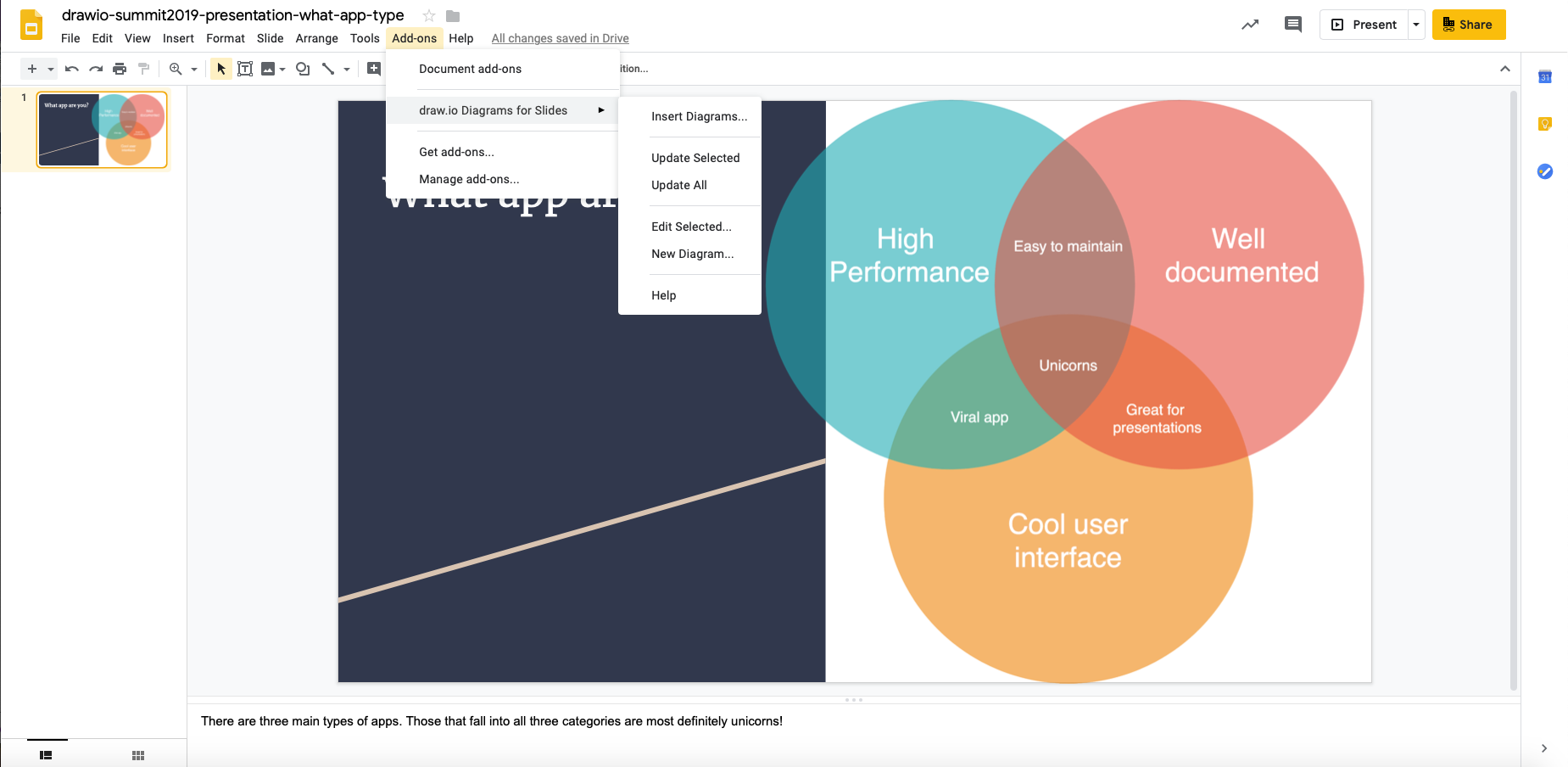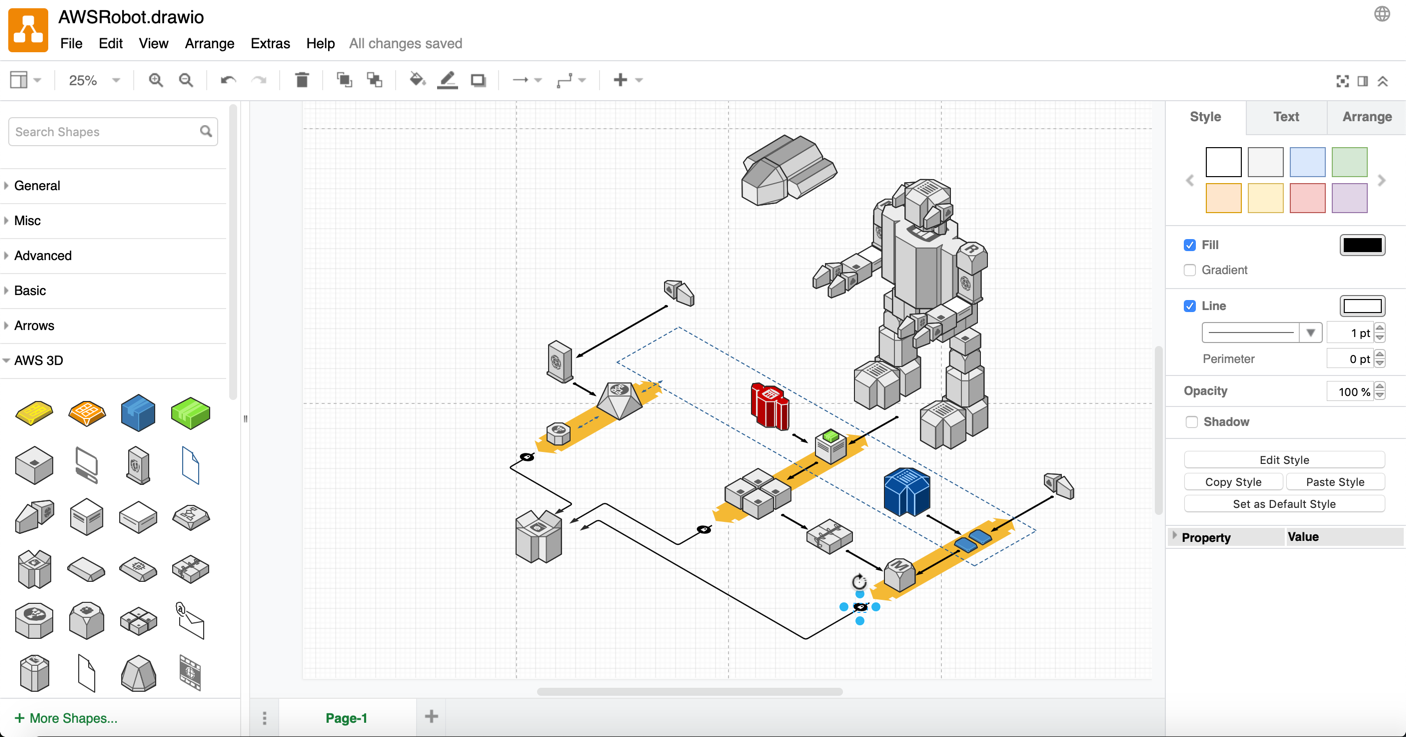draw.io integrates with many popular software tools
There is a large collection of tools and platforms that have integrated draw.io. Just as there are many different types of diagrams for different use cases, different departments use different tools for different reasons. Software developers use task trackers, human resources uses an intranet platform for documentation, while marketing uses cloud storage to store their media files.
Note that we, //SEIBERT/MEDIA, are the vendor for only the integrations within the Atlassian ecosystem. The core draw.io project is also named draw.io and isn’t a project under our control.
Atlassian
Confluence (Server, Data Center and Cloud): Collaborate on all kinds of diagrams with your co-workers in a knowledge base, document code, prepare user manuals, track business processes, collaborate on marketing infographics and develop business plans. Your diagrams are stored centrally and securely, and all changes are tracked.
Even if you store your draw.io diagrams on Google Drive or Team Drives, our app lets you embed your diagrams in Confluence pages.
Jira (Core, Software, Service Desk, Server and Cloud): Add diagrams directly to the tickets to make debugging, development and customer service better and faster. Use flow charts to show how to reproduce bugs, UML diagrams and mockups to develop software, process charts as you refine business, service or manufacturing processes.
Trello: Even if you are using the lighter task tracking service at work or privately, you can add draw.io diagrams to Trello cards to communicate more clearly.

Google Docs – Many freelance authors write content for multiple companies and sites, and Google Docs is their go-to tool for sharing the content to be published. Instead of having to email diagram files and images separately, you can develop them within the Google document itself!
Google Slides – We’re sure you have experienced that well-known frustration when trying to use presentation software tools to create diagrams. You can easily import the draw.io diagrams stored in Google Drive into your presentation slides and update them throughout the presentation in just a couple of clicks, should you need to edit them.
We have recently released an update that introduces collaborative editing – now multiple users can collaborate on a draw.io diagram stored in Google Drive at the same time!

draw.io online
The core platform for draw.io is available online, for free! You don’t even have to register to use the software – just choose where you want to save your diagram data (on your device or on one of the supported cloud services). To try it out, go to https://www.drawio.com.
When you are working on your diagram, your data stays in your browser and is saved to the selected location. It is never stored on the draw.io servers. If you choose to save using a cloud-based service, your data will be end-to-end encrypted between your browser and the cloud provider. That means your data is always secure and private when you use draw.io online.
Also, because draw.io is commercial open source, you won’t be bombarded with ads!
draw.io Desktop
The stand-alone desktop version, draw.io Desktop, does not require an internet connection and is available for Windows, MacOS, and Linux. Download draw.io Desktop at get.drawio.com
Tip: If you don’t have admin rights on your computer, draw.io can be installed as a Progressive Web App (PWA) from your browser.

Third-party integrations
With the source code available on Github, you (anyone!) can develop your own integrations. Right now, we have posted few examples in JGraph’s draw.io open source repository on GitHub including WebDav, HTML5, and GitHub that developers can use to create their own integrations. Many integrations already exist!
Note: We are not able to provide direct support for these third-party integrations, but we think it’s fantastic how the open-source developer community values diagramming enough to integrate draw.io into their software solutions!
Aha!
Aha! now integrates draw.io so that product managers and developers can develop mockups and flow diagrams as they work on their product roadmaps and marketing planning without switching tools.
Atom
This modern ‘hackable’ text editor, commonly used for code development, now has a package that lets you edit draw.io diagrams directly from within the Atom editor.
BookStack
An open source information management system, BookStack has integrated the draw.io editor so you can convey information more easily in diagram format.
Docstell
The draw.io editor is fully integrated in the Docstell documentation system. The aim of Docstell is to make software documentation as easy as possible for developers to write and collaborate on.
FOSWiki
A collaboration tool that lets you combine text and structured content, macros and data from web APIs, FOSWiki integrates draw.io with this DrawIOPlugin.
Grafana
You can now add complex diagrams, floor plans, UML diagrams, flow charts and more with Arnaud Genty’s open-source draw.io plugin for the Grafana analytics and modeling platform.
JupyterLab
QuantStack has released a standalone integration (embedded) of draw.io in JupyterLab, the web interface for Project Jupyter, letting you combine content types like runnable code snippets, LaTeX, images, interactive diagrams and more.
LumApps
As one of the few intranet platforms that works well with G Suite, LumApps has recently integrated draw.io – you can now quickly and easily insert draw.io diagrams into your LumApps content.
MediaWiki
There are two extensions available for MediaWiki, Drawio (not actively maintained) and the more recent DrawioEditor, letting you create diagrams inline in your MediaWiki pages.
Nextcloud
Pawel Rocek has released a draw.io Nextcloud app – you can now create diagrams from within Nextcloud, a file share and communication platform with strong security and monitoring features.
Nuclino
As a lightweight collaborative content development platform, Nuclino has integrated draw.io so that you can embed your draw.io diagrams easily and attractively.
ownCloud
The ownCloud open-source collaboration platform has integrated the draw.io editor into its ownCloud file editor app, letting you create and modify draw.io diagrams.
Redmine
Redmine is a flexible project management web application, based on Ruby on Rails. You can create diagrams in your project documentation using the Redmine draw.io plugin.
Samepage
Team collaboration needs diagrams, and Samepage now integrates draw.io – develop diagrams, track tasks, share files, communicate and work on project content all in one place.
Sandstorm
You can create personal/private instances of web apps and create draw.io diagrams via Sandstorm.io, an open source hosting platform.
WordPress plugin
Released by AssortedChips, DrawIt! allows you to create draw.io diagrams while editing your blog posts in WordPress.
XWiki
You can create draw.io diagrams in XWiki, a lightweight wiki software by using the Diagram Application extension, based on draw.io.
Want to see draw.io diagrams supported in Azure DevOps?
If you’d like to be able to create UML diagrams, flow charts and mockups using the draw.io editor and use them in your Azure boards and wiki, please vote up this feature in Microsoft’s developer community!
Cloud storage for diagram files
Your diagram data is secure and private when using draw.io. Your diagrams are never stored on the draw.io servers. If you aren’t allowed to use a cloud solution for security reasons, you can save your diagram files directly to your device. The following cloud storage platforms are currently supported:
- Google Drive and Team Drives
- Microsoft OneDrive
- GitHub
- Dropbox
- iCloud via your device
Import and export – draw.io supports many formats
We want to make it as easy as possible for everyone to diagram and to share their diagrams, even when they use other diagramming tools.
Our team works hard to make it easy for you to import diagrams from other tools and export diagrams into many different formats.
In addition to the import formats in the table, you can also enter .csv data, PlantUML code, and Graphviz DOT code via menu functions to generate diagrams from the code automatically.
Third-party support for the .drawio format
Many IT specialists and software developers have their favorite tool. For example, many systems administrators like to create their AWS diagrams dynamically. But not everyone has access to this tool – the company architecture should be documented in a static format that everyone can access.
Since draw.io is open source, it is easy for such companies to support the .drawio XML file format – both Cloudcraft and Cloudockit can export to draw.io.
| Import formats | Export formats |
| .xml .vsdx, .vsd, .vdx .gliffy .png (with embedded XML) .svg (with embedded XML) .jpeg .gif .vssx, .vsx, .vss .json |
.xml .vsdx .html .png (with embedded XML) .svg (with embedded XML) .jpeg .url |
Last Updated on May 8, 2023 by Admin

